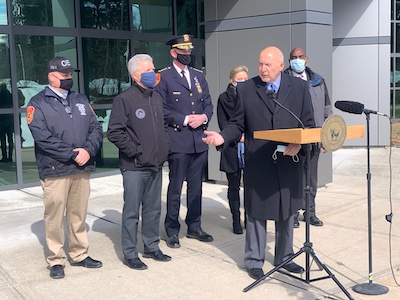Carl Corry
Renee Castelli, a 25-year nurse, started as an adjunct clinical instructor at the Michael J. Grant campus in January 2020—just before the Covid-19 outbreak—teaching Adult Physical Health Nursing I, a major part of which required clinical training at Long Island Community Hospital in East Patchogue. “It just so happened that the very last clinical I had with them happened to be the first day they were shutting down having to go into facilities…. I was new to teaching at SCCC and then Covid hits,” said Castelli, who wound up taking on the second half of the semester via Zoom with students she had not met before. Castelli, previously a clinical teacher at Stony Brook University’s nursing program who earned a master’s in nursing education in 2019, commended the nursing program’s administration and her colleagues for quickly adapting to the needs of students and faculty. The dire situation presented nursing students in particular with rare educational opportunities. “It turns out that with Covid going on, it was a good time for people to share experiences, such as if students went on ambulance calls.” And when Covid vaccinations became available, a state special order permitted students and others to administer vaccines with the proper skills training, and 45 SCCC students were certified under the guidance of nursing faculty. “It’s more than just pushing in the needle,” explained Cheryl Shaffer, associate dean of the 400-plus student School of Nursing, of the vaccination process and training. “You draw up the correct dose, read the label, select the proper injection site” and process documents. “They have to make a lot of decisions.” “None of this could be done without faculty support,” Shaffer added. “Students have to be certified and trained by the faculty and then we have to attest that they can administer the vaccination.” SCCC nursing students were commended by the county for their volunteer efforts and, in one example, made a special impact at the Hamptons Bays Elementary School Point of Dispensing (POD), where Castelli’s clinical class this semester was assigned to help administer vaccines on April 6. Also, one student assessed that someone was ineligible for the vaccine that day because he had gotten a separate meningitis vaccine a week earlier. “It could have caused him a health problem,” Castelli indicated. Regarding administering intramuscular (IM) injections, which the students had been instructed to do in class, “They not only learned that skill but they became proficient in doing so,” Castelli said. Two of the students administered IM injections for the first time that day. “But they were not just doing vaccines. They were assessing patients. Everything they learned in the lecture, they were just applying this to the community.” She added, “When I was in nursing school, the first IM injection was years into my training. These students had to give out at least 50.” “Sometimes they would just stop and say. ‘I'm in school, but I’m really doing something. I’m here to help stop this pandemic.’ A lot of them were emotional.” The students’ day, which started at 9 a.m., was supposed to end at 6 p.m., but due to cancellations, there were more than 40 vaccines left. Most people had to leave, including two of the nurses, but 32-year-old second-year student Anthony Harris, an advanced life support provider for the Patchogue Ambulance Co. and Brentwood fire district and an East Brentwood firefighter, volunteered to stay until patients on the waiting list could be called in and the vaccines could be administered. “I said, 'OK, Anthony. If you want to stay, I’ll stay with you,'” Castelli said. Harris, a father of two who was isolated from his family early in the pandemic when it was still unclear what Covid was as he saw “tons and tons of people going into emergency rooms very sick,” said it was a very long day at the POD, and though there is a lot of work piling up near the end of the semester, he wanted to see the process through. Harris, a student liaison to the School of Nursing, also said he didn’t want to leave the one remaining staff member to complete the job. He added that he has been doing IM injections since 2006, “but it’s a little different in a vaccine clinic than bumping around in the back of an ambulance,” and Castelli offered him a few tips and tricks. The overall experience left him feeling optimistic, especially since he normally sees patients in a critical setting. “To see all these people excited and so willing to participate, it gave me a sense of pride that these people were doing it. I come here and administer this vaccine and fight this virus in a different way,” said Harris, who administered the 588th vaccine and left at 7:15 p.m. |
